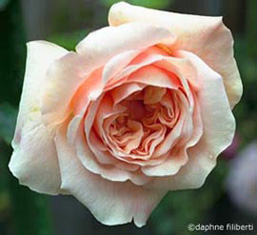 Last year I showed my garden to several acquaintances that were interested and curious about my
garden. 'Mme Hardy', 'Sombreuil', 'Fantin Latour', and some of my Gallicas were mistaken for
David Austin Roses. This is very interesting because I would call David Austin Roses modern.
The other roses I mentioned are antiques. Last year I showed my garden to several acquaintances that were interested and curious about my
garden. 'Mme Hardy', 'Sombreuil', 'Fantin Latour', and some of my Gallicas were mistaken for
David Austin Roses. This is very interesting because I would call David Austin Roses modern.
The other roses I mentioned are antiques.
I don't know why modern has negative connotations for some people. David Austin's Roses are
not Brave New World Roses that are created in a sterile laboratory off the freeway somewhere,
where trees don't grow. They aren't roses that appear like plastic without fragrance. In
fact they are mostly sensual and tactile, combining the best of the old world with what we've
learned about roses over the years. David Austin Roses seem to be created at an intersection
where science meets God.
In the case of David Austin roses what is meant by modern is that he has taken the best of the
past and combined it with a load of experience, resulting in a unique breed of roses, sometimes
referred to as English Roses. You may feel that they are other worldly, some of the most
extraordinarily beautiful specimens that our Earth has to offer. The ancients used to
attribute the beauty of the rose to the Gods from early times on. If they saw David Austin's
roses, they would probably worship the soil where they grew. I am speculating, but I think
I've made the point.
David Austin Roses come from many genetic lines. Someone asked what the difference is between
say Bourbons and David Austin Roses. The difference is that no one is really breeding Bourbons,
Portlands, Hybrid Musks, Hybrid Chinas, or Noisettes, these days. For the most part Hybrid
Perpetuals have been replaced by the more popular Hybrid Teas. Some rosarians have fabulous
collections of Hybrid Perpetuals, but people are not breeding new ones. David Austin has taken
roses from many lines and crossed them, so there is a full gamut of habit, disease resistance,
shape, form, fragrance, tolerance to different climates, and coloring. Some are even like
fragrant Floribundas. Although the roses are classed together, we really can't conclude about
their habit as a whole-like we might Gallicas, or Albas let's say. There are too many genes in
the pool.
In any event, the David Austin's are new and exciting. It is wonderful to live in a time when
their popularity is exploding. I can only imagine what it was like to live at the time of the
turn of the eighteenth century, when what seems to be the last revolution in roses occurred. I
think that David Austin's Roses have had a profound impact on our rose gardens. His roses have
retrained my eye. I am always looking for creative ways to integrate them into the landscape.
There are so many dimensions to their beauty. His books have helped me understand his
philosophy. As a lover of roses, it is difficult not to be innovated to add these roses to the
garden, the vase, or the party. These are the roses I choose to give, when I want to show
someone I care.
English Roses are the now roses. One day they will be antiques. Who knows what they will
think then. They will most certainly receive high praise.
I live in Southern California where English Roses behave differently than they might in
England, let's say. From what I have seen of these roses they can adapt quite differently to
gardens given the same climate. Here in Southern California we are notorious for our English
Roses that behave differently then they would in other areas. They have received some
criticism for being tender as a whole. All I can do is share my experiences with you. I can
describe the roses in my garden and explain how they have done. There are many experts on
English Roses. Peter Schneider has information and a newsletter that might be helpful if you
live in colder areas of the U. S. I would also suggest going to a local rose garden (hopefully
there is one) and seeing which roses do well in your area. A local rose society may have some
answers. (Try the American Rose Society, or Heritage Rose Group) Link to my page on rose
societies for more help on Peter Schneider or Rose Groups here: Rose
Societies |













